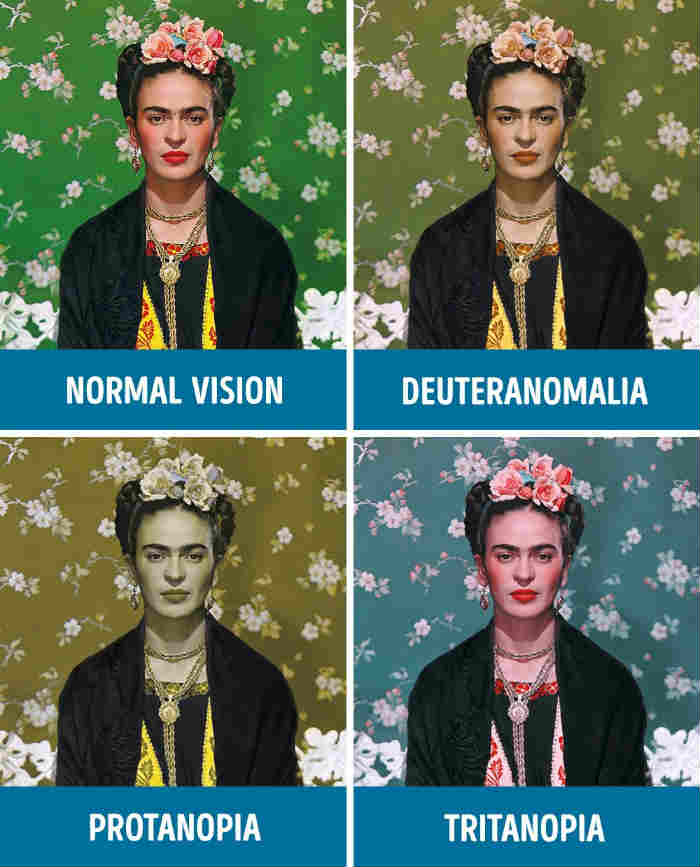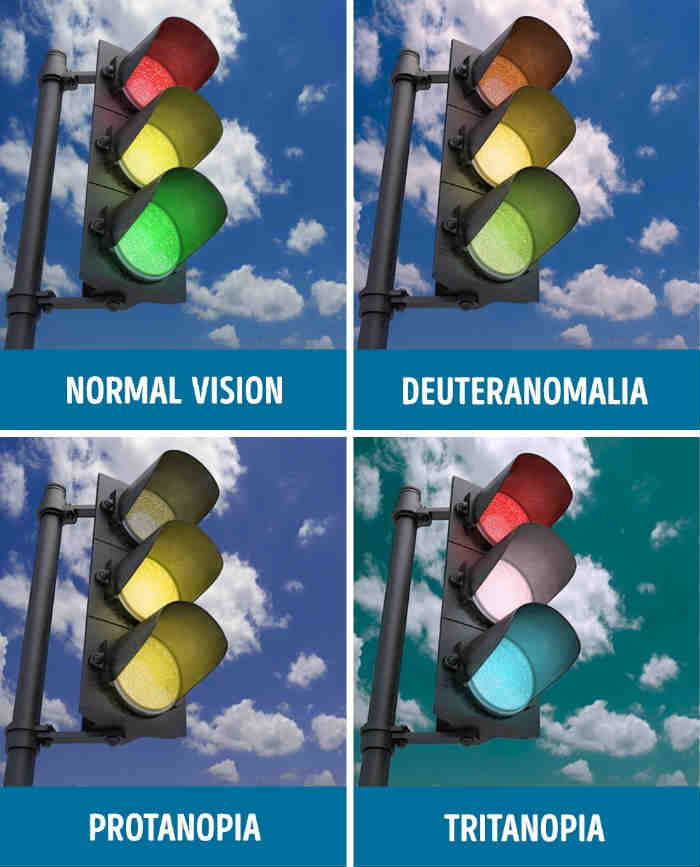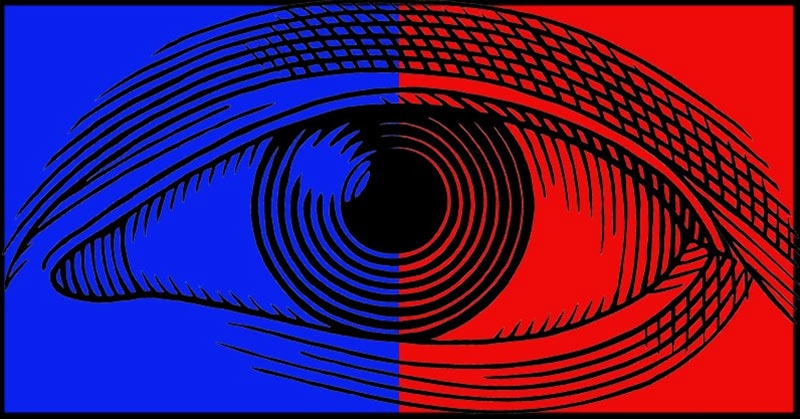Have you ever taken one of those color vision tests? They’re used to determine if you have color vision deficiency, a condition that’s usually inherited. If you have poor color vision, your ability to see the difference between specific colors is lessened. You may have one of the four types of color blindness!
People with color vision deficiency do not always know they have it! Usually, people find out in real-life situations, such as pulling up to traffic lights and not knowing exactly what colors are showing. Most commonly, people affected by the four types of color blindness see different shades of red and green and/or different shades of blue and yellow.
What is true color blindness?

Although many people equate color vision deficiency with color blindness, true color blindness actually describes someone who only sees in shades of black and white — which is rare. But here’s a quick to help determine whether you have a color vision deficiency or not. Only people with perfect color vision who aren’t impacted by any of the four types of color blindness can read these eight words without hesitation! Can you? We’ll give you the answers at the end of the article.
Read More: What Are Those Colorful Balls You See on Power Lines?
1. Can you see the blue word?

Interestingly, while individuals with color blindness may struggle with distinguishing shades of blue from other colors, blue itself is often a color they can perceive relatively well. This is because blue is detected by different receptors in the eye compared to red and green, which are the colors most affected by color blindness. Therefore, blue can sometimes serve as a reference point or anchor for those with color vision deficiencies.
2. Can you see the green word?

Some individuals may perceive green accurately while struggling with other colors. Green’s prominence in nature and its frequent use in signals and signage mean that color-blind individuals often develop strategies to navigate its various shades, relying on context cues or alternative visual information to interpret its significance.
3. Can you see the purple word?

For individuals with red-green color blindness, purple may appear closer to blue or red, depending on the specific deficiency. Similarly, those with blue-yellow color blindness may have difficulty perceiving the red component of purple, causing it to appear more blue. Despite these challenges, the distinctiveness of purple in many contexts, along with surrounding cues, can aid color-blind individuals in identifying it, albeit with potential variations in perception compared to those with normal color vision.
4. Can you see the pink word?

Pink may appear duller or closer to gray, especially in contexts where it’s not clearly distinguished from red. However, because pink is often used in distinct contexts, such as clothing, branding, or signage, individuals with color vision deficiencies can often rely on contextual cues to identify it. Despite potential difficulties, variations in brightness and surrounding colors can help differentiate pink from its surroundings, assisting color-blind individuals in recognizing its presence.
Read More: The Tree of 40 Fruit is indeed a coat of many colors
5. Can you see the blue word?

One fascinating aspect of color blindness and blue perception lies in its role as a reference point for those with color vision deficiencies. While individuals with red-green color blindness struggle with distinguishing between these colors, blue is often perceived accurately due to its detection by different receptors in the eye.
6. Can you see the orange word?

Depending on the specific deficiency, orange may appear either yellow or red. The similarity in the components of orange to those of red and yellow can lead to confusion in perception. However, contextual cues, such as brightness or surrounding colors, can often aid color-blind individuals in identifying orange, albeit with potential variations in hue compared to those with normal color vision. Despite these challenges, the distinctiveness of orange in many contexts, such as traffic signs or fruit, ensures that color-blind individuals can navigate and interpret its significance effectively.
7. Can you see the purple word?

Color blindness, particularly affecting red and blue perception, can offer intriguing insights into how individuals perceive purple. As purple is essentially a combination of red and blue, individuals with red-green color blindness may struggle to differentiate it from other colors, perceiving it as closer to blue or red depending on the specific deficiency.
8. Can you see the red word?

For individuals with this type of color blindness, red may appear duller or darker, or it may be mistaken for other colors, such as brown or green. This can have significant implications in various aspects of daily life, such as interpreting traffic signals or identifying ripe fruits. Despite these challenges, individuals with color blindness often develop strategies to navigate their surroundings, relying on contextual cues or alternative visual information to compensate for their deficiency in perceiving red.
Read More: Is coloring hair safe? Dye, straighteners may increase breast cancer risk, study finds
See the answers below:

- TREE
- EAT
- BOOT
- SWEET
- PARK
- LOVE
- HAT
- BEAD
If you were able to see all of the words above, you likely don’t suffer from any of the 4 types of color blindness. Perspective is an amazing thing that can unite or divide people, countries, continents, and more. While different opinions contribute to that, how we see the world in a literal sense is another source of perspective.
Read More: For The First Time In 71 Years, The Most Beautiful Flower Garden In The World Has No Visitors
Types of Color Blindness

Color blindness – or color vision deficiency (CVD) – affects approximately 8% of men and 0.5% of women.[1] Broadly, there are four types of color blindness (it’s not just seeing in shades of grey) and we have some pictures to show you what each looks like.
Total Color Blindness

We’ll cover this one first because while it exists, it only occurs in 0.00003% of the world’s population.[2]
Deuteranomalia

About 4.63% of men unknowingly suffer from this form of color blindness, making it the most common form. Colors, especially reds and greens, will seem faded or lack their natural brightness.
Read More: Did You Know the Color of the Carbs You Eat Matters? This Doctor Explains Why
Protanopia

1% of men have this less common form of color blindness. There seems to be a greater contract in Protanopia because while all reds and greens will lack brightness, other colors such as yellows and blues tend to stay the same.
Tritanopia

This form of color blindness affects both men and women equally, but rarely and at very minimal levels. People will this CVD perceive the world in tones of pink and green.
Colorblind Comparisons

By recognizing and accommodating differences in perception, we foster a world where everyone’s unique strengths and perspectives are celebrated, contributing to a more compassionate and harmonious society.
Read More: 32 Interesting And Unexpected Facts About The Female Body

